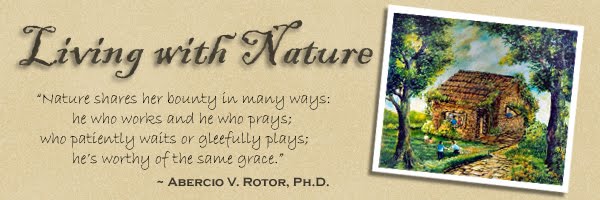Dr. A.V. Rotor
MULTIPLE CHOICE: Copy the letter of the correct answer
A. In the preparation of wine and vinegar from local fruits, the following steps are involved:
A. Inoculation of yeast B. preparation of the must C. fermentation proper D. aging E. Oxidation
___1. Arrange them according to SOP. A. a-b-d-c-e B.-a-c-d-e b C. b-d-b-c-e D. b-a-e-c-d
___2. The enzyme produced is zymase. - A
___3. This consequently transforms ethanol into acetic acid. E
___4. This involves mashing of fruits with table sugar.B
___5. Mellowing of taste is the principal objective. D
B. Natural ecosystems are sacrificed by certain socio-economic projects such as the following: A. Building of golf courses B. Urbanized communities C. Industrialization D. Intensive agriculture E. 3-Mile Island nuclear accident.
___6. Displaces pasture land, farmlands and wildlife areas. A
___7. Chemicals are washed into rivers, lakes and sea. D
___8. Emits radioactive fallout that affects many countries. E
___9. People become concentrated in a limited area. B
__10. Results in the production of non-biodegradable by-products such plastics and oil spills. C
C. These are dihybrid crosses to show dominant and recessive traits. The parents are shown as follows: A. TTRR (tall round-seeded) x ttrr (short wrinkle-seeded B. Tt Rr x TtRr C. TtRr x tt rr D. ttrr x ttrr E. Not applicable.
__11. The offspring are 1 tall round-seeded, 1 tall wrinkle-seeded, 1 short round seeded and 1 short wrinkle-seeded. C
__12. The phenotype ratio of the F1 is 9:3:3:1 B
__13_Offspring of the first filial generation are all tall round-seeded A
__14. The F1 offspring are medium - they are neither tall nor short, round nor wrinkle seeded E
__15. The F1 offspring are all short wrinkle seeded. D
__16. The genotype ratio of the F1 is 1:1:1:1 C
D. These are acronyms: A. BSE-CJD B. DNA C. GMC D. SALT E. SWIP
__17. Popularly known as Mad Cow Disease which originated in Britain. A
__20. Answer to “kaingin” or slash and burn agriculture. D
__16. Known as Code of heredity, the discovery of this millennium. B
__18. Frankenfood, after the horror fiction, Frankenstein. C
__19. A miniature of Pantabangan Dam E
E. Among the major ecological systems or biomes of the world are as follows: A. Savannah B. Tundra C. Grassland D. Alpine E. Tropical Rainforest F. Taiga g. Chaparral
__21. Safari or game of hunting wild animals is the scenery in this biome. A
__22. Coldest of all biomes, only bryophytes at certain times of the year can survive. B
__23. The prairies of North America, inhabited by the early American Indians. C
__24. In terms of diversity and population density this is the richest of all biomes E
__25. Gymnosperms virtually appear to be singularly occupying this biome.
F. Identify the position of the following in the Food Pyramid A. producers B. herbivores C. decomposers D. 2nd order consumers E. 3rd order consumers
__26. Larvae of dragonfly (naiad) D orE
__27. Arachis hypogea A
__28. Chanus chanus philippinensis B
__29. Philippine Tarsier D or E
__30. Diatoms A
G. Here is a case study whereby fishponds are built on formerly natural ecosystems of mangrove estuaries, a business venture in supplying the market with prawns and bangus. Among the effects are A. Destruction of the ecosystem. B. Endangerment of the local species C. Pre- disposition to erosion and siltation D. Blocking of waterways E. Loss of indigenous industries and livelihood.
__31. The displaced area is no longer a climax community. A
__32. Shifting soil and detritus cannot settle down and stabilize. C
__33. Fisherfolk find riverine transportation becoming difficult. D
__34. Firewood, tangal for dye and fermentation, and the like, become unavailable. E
__35. As a breeding place, marine life cannot go through the natural life cycle. B
J. Environmental degradation can be arrested/minimized in our own way with governments, NGO and the citizens working hand on hand. A. Waste segregation scheme Program B. Microbial decomposition C. Use of atmosphere-friendly compounds, in lieu of CFCs. D. Vehicle volume reduction scheme
__36. Nature’s way of getting rid of wastes with the aid of unicellular organisms. B
__37. These are so-called alternative energy sources. C
__38. A palliative measure to ease traffic and reduce pollution in Metro Manila. D
__39. Garbage collection is easier and systematic for recycling and disposal. A
__40. Give relief to allow nature to cope up with the thinning of the ozone layer. C
I. For five billion years the year has been undergoing change. Life for one has been a long struggle as evidenced by as evidenced by the following developments: A. The unicellular organisms were the first inhabitants on earth. B. Man is among the recently formed species. C. “Only those species which are the fittest will survive.” D. Now and then Nature commits error through mutation. E. All organisms are said to be continuously evolving.
__41. Chromosomal aberration occurs unpredictably. D
__42. Blue-green algae or cyanophytes are still around today, possibly as abundant as before. A
__43. It was Darwin who thought of this as a theory – and now as an acknowledged principle. C
__44. This explains why there are freaks and variants among living things. D
__45 Only change does not change – the world is always undergoing dynamic changes. E
RATING:
41 - 45 Very Good
35 -40 Good
30 - 34 Passed

No comments:
Post a Comment